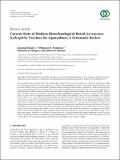| dc.description.abstract | This systematic review describes what "the cutting edge vaccines for are". The focus is on types of high tech biotechnological based vaccines, target gene or antigen in developing these vaccines, and challenge model fish species used in vaccines efficacy testing. Vaccines delivery methods, immune response, and their efficacy, adjuvant or carrier systems used, and the overall experimental setup or design of the vaccines under investigation are also described. The search for the original papers published between 2009 and 2018 was conducted in June of 2018, using the PubMed and Google scholar electronic database. Twenty-three (23/4386) studies were included in the final assembly using PRISMA guidelines (Protocol not registered). Recombinant protein vaccines were the highly experimented type of the modern biotechnological based vaccines identified in the selected studies (16/23; 70%). Outer membrane proteins (OMPs) of different -barrels were shown to be a potential antigenic entity for vaccines (57%). Intraperitoneal route with conventional carries or adjuvants was the highly applied delivery system while very few studies used herbal based vaccine adjuvants and nanomaterial as a vaccine carrier. Variation was observed in terms of protection levels in the selected studies. The experimental designs partly contributed to the observed variation. Therefore, recombinant vaccines that use new carrier system technologies and delivered through oral route in feeds would have been of great value for use in the prevention and control of infections in fish. Despite the usefulness as academic tools to identify what is important in pathogenicity of the etiological agent to the host fish, these vaccines are only economically viable in very high-value animals. Therefore, if vaccination is a good option for group, then simple autogenous vaccines based on accurate typing and evidence-based definition of the epidemiological unit for their use would be the most viable approach in terms of both efficacy and economic feasibility especially in low and middle-income countries (LMIC). | en_US |

